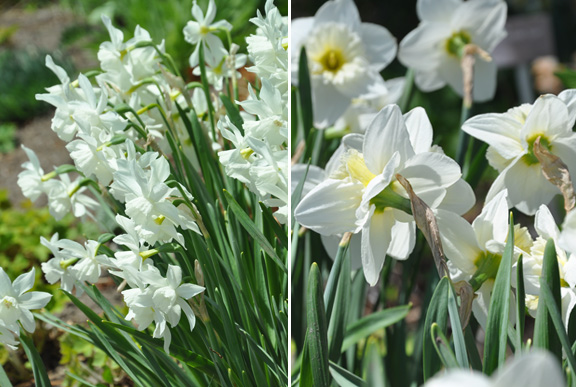The notion of creating a white garden in part-shade or shade is an interesting twist on a classic idea. It's also an idea that works on more than just a design level. When you step out of the hot sun into the shade there is always a sensation of relief. The canopy of trees overhead provides such a welcome respite from the heat, you can feel your body relax. The change is refreshing, and so is the color white.
Contrast allows white to stand out while other colors fade into the shadows. White also has a luminous quality that can brighten a shady corner of any garden.
In a white shade garden, it would be really fun to use variegation to compliment the white flowers.
1. Yew 2. Golden Shadows Pagoda Dogwood 3. May Apple, Podophyllum peltatum which is a native plant. 4. Solomon Seal, Polygonatum 5. 'Butterfly' Japanese Maple 6. Astilbe 7. Astilbe 8. Astilbe
I doubt that all the flowers in the garden above are actually white, but I think it is an excellent example of how foliage colors might be used in creating a white themed shade garden.
In the famous white garden at Sigginhurst Castle, Vita Sackville-West used plants with silvery foliage to play off the white flowers. A contemporary shade garden might use blue-grey hosta in a similar way.
'Joy Ride' not only has great curves, it also has foliage with a wonderful powdery, blue-green color. Light lavender flowers appear mid-summer. Part-shade to full shade. Height: 40-45 cm (16-18 inches), Spread: 90 cm ( 35 inches). USDA zones: 3-9.
There are a huge number of hosta with white flowers. Here are just a few of them:
Green Leaves: 'Guacamole', 'Guardian Angel', 'Journey's End', American Icon', 'Brother Stephan', 'Fragrant Bouquet', 'Earth Angel', 'Cinderella', 'Faith',
Blue-green Leaves: 'Humpback Whale', 'Blue Angel', 'Coalminer', 'Fragrant Blue', 'Frosted Dimples', 'Komodo dragon'
You might also use other plants like native White Banberry, Actaea pachypoda 'Misty Blue' and Japanese Ferns that have silver-greens.
Actaea pachypoda 'Misty Blue' has blue-green foliage and white flowers in spring. In summer the flowers become white berries on contrasting red stems. This plant prefers sandy or clay soil with average to moist growing conditions. Height:60-90 cm (23-35 inches) , Spread: 60-90 cm (23-35 inches). USDA Zones: 3-9.
Japanese 'Ghost Fern' has that has upright, silvery-grey-green foliage. It forms a slow spreading clump and likes soil that is rich in organic matter. The 'Ghost Fern' is more tolerant of soil dryness than other types of Japanese ferns, but it prefers soil that has medium to average moisture. Height: 90-120 cm (36-48 inches), Spread: 30-45 cm (12-18 inches). USDA Zones: 4-9.
Daffodils bloom early in the gardening season so they can get some sun
before trees overhead leaf out.
Trilliums (left), Violet (middle) and Snowdrops (right).
There are probably more white flowers for moist shade than there are for dry shade, but I think a white garden might be made to work for either set of growing conditions.
Primula Sieboldii for moist shade.
Woodland Phlox, Phlox divaricata 'May Breeze' has fragrant, star-shaped white flowers in early spring. Unlike more familiar Phlox paniculata that blooms much later in the summer, this plant has fine, delicate foliage. Phlox divaricata 'May Breeze' slowly spreads to form a small clump. Divide in the fall. Moist soil and part to full shade are this plants preferences. Height: 30-40 cm (12-16 inches), Spread: 30-60 cm ( 12-23 inches). USDA zones: 3-9.
Bloodroot, Sanguinaria canadensis is one of the native options for shade.
Bleeding Heart, Dicentra spectabilis, 'Alba' has bright green foliage and white flowers. Height: 70-90 cm (27-35 inches), Spread: 70-90 cm (27-35 inches). Light shade to full shade. Average to moist soil. Hardy: Zones 2-9.
Foam flower, Tiarella is great in moist, shady conditions.
Solomon's Seal, Polygonatum. Read more about this plant here.
A Doublefile Viburnum, Viburnum plicatum f. tomentosum
Sweet Woodruff is a spreading groundcover for shade.
Valerian, Valeriana officinalis for moist, part-shade (but will tolerate some dryness).
This plant can be a prolific self-seeder.
This plant can be a prolific self-seeder.
Here is a list of white flowers for shade. If you have any other suggestions, please leave a comment and I'll update the list:
White Flowers for the Spring Shade Garden:
Bulbs: Hyacinth, Daffodils, Snowdrops
Annuals: Pansy, Sweet Alyssum
Native plants: Trillium, Gilleau, Shooting Star (Dodecatheon), Dutchman's Breeches (Dicentra culcullaria), Bloodroot (Sanguinaria canadensis)
Perennials: Violet, Hellebore, Bleeding Heart, Foxglove, Astrantia, Japanese Iris (part-shade)
Groundcovers: Lamium 'White Nancy', Lily-of-the-Valley (aggressive plant*), Vinca (aggressive plant*), Sweet Woodruff (spreading groundcover)
Shrubs & Trees: Azalea, Rhododendron, Viburnum, Fothergilla gardenii, Star Magnolia, Dogwood, Service Berry
*Aggressive plants: I think it is important to put all the cards on the table. I do not mean to recommend aggressive plants. Quite the contrary. These plants can however have their uses. Just be cautious and make sure you choose your location carefully so the plant's aggression may be contained.
White Flowers for the Summer Shade Garden:
Annuals: Impatiens, Wax begonia
Perennials: Astilbe, Goat's Beard (Aruncus), Hosta, Phlox (part-shade), Sedum (part-shade)
Shrubs & Trees: Hydrangea (part-shade)
Climbers: Climbing Hydrangea, Rambling Rose (part-shade only)
White Flowers for the Fall Shade Garden:
Perennials: Actea (formerly Cimicifuga), Japanese Anemone (can be an aggressive spreader)
I think creating a white garden in shade is such an interesting challenge I'd love to find a way to take on the task myself. If only my garden were bigger....




















I have started a shade garden and have been challenged with finding plants for it that look pretty through summer and fall. This post has given me some new ideas. Thanks for sharing.
ReplyDelete